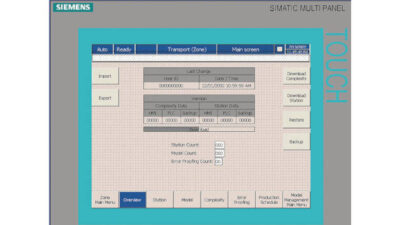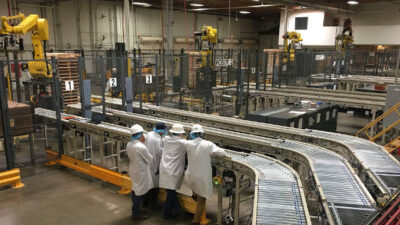Engineering and IT Insight: To stay on time and in budget, software project managers need to prepare for challenges with other organizations, develop a flexible plan and schedule to handle uncontrollable delays, develop an external communication plan, and develop plans to use resources for other parts of the project when there are delays.

Project management for manufacturing IT projects has become a more difficult task as more manufacturing systems must integrate with other corporate systems and as automation systems in general must operate under corporate IT policies and procedures. We are long past the days where Level 3 systems, such as MES, LIMS, SCADA, historians, warehouse management, and maintenance, could operate independently of the corporate environment. These systems must now integrate with the corporate network structure, user access control systems, security policies, database systems, and server farm systems.
A project manager must spend considerable time and effort in coordinating with separate IT organizations that manage the many different aspects of a modern IT system. One organization may centrally manage all database systems with a separate organization that was put in place due to SQL injection attacks and the need to protect all corporate data. Another organization may be a network services organization that manages all new network connections and assignment of network resources, put in place to guard against rogue devices and rogue network attachment points that compromise system security. A third organization may be responsible for firewalls and firewall rules that must be configured to allow automation and manufacturing applications to communicate with other corporate systems, put in place to protect against computer worms and viruses. There may be additional independent organizations to handle user access credentials, system hardware upgrades, and virtual system resource allocation. A project manager will be continually coordinating and negotiating with these organizations to meet the project’s schedule.
A project manager’s role is similar to that of a general contractor who coordinates the building of a house. A general contractor must coordinate tasks that are often sequential with different groups that have their own schedules and priorities. A general contractor may have to coordinate site preparation, inspection, concrete delivery, inspection, framing, roofing, inspection, plumbing, inspection, electrical, inspection, HVAC, inspection, drywall, painting, and more inspections, all of which may be performed by independent subcontractors. Anyone who has waited days or weeks for an inspector or subcontractor understands that unplanned delays usually occur.
A project manager must operate more as a general contractor than a traditional project manager who has responsibility for all of the resources needed. A manufacturing IT project manager must coordinate server purchases, server installations, network device purchases, network device installation, user access plans, networking routing and firewall rule planning, database updates, ERP changes (if integrating with the corporate ERP system), automation changes (if integrating with automation equipment), and, finally, the project’s software purchase and installation or development and deployment. Often, only the final element is under the direct control of the project manager, yet the he or she has responsibility for setting and meeting the overall schedule. A project manager must develop a flexible schedule with multiple alternatives and plans for handling unforeseen delays. One way to remember the need for advanced planning for alternatives with external organizations is the ANCHOR STEAR model. This stands for Advanced Notice (AN), Checkpoints (CH), Order Service (OR), Scheduling (S), Talk (T), Execution (E), Analyze (A), and Repeat if needed (R).
When working with external entities, it is critical to provide them with advanced notice (AN) that you will need their services. This notice should come before you have a detailed schedule so that you know what their lead times are and their expected resource availability. Many organizations need weeks of lead time to perform tasks, even when the tasks may just take hours to complete. Your advanced notice must come before you schedule and place the order for the service, because you cannot develop your own schedule until you know the service provider’s availability. The next step is to have checkpoints (CH) on the service provider. Your advanced notice may be months before you order the service, and it is important to check that the provider’s schedules and resource availability have not changed. You should then order the service (OR) before you set your firm schedule. Ordering the service is the final checkpoint where the service provider lets you know when it can perform the service.
Once you have the services ordered, you can firm up your schedule (S). Prior to service delivery, you should talk (T) to the provider on a regular basis to ensure that its delivery schedule has not changed. If it has a change, you can still replan and reschedule before you need the service executed. Once the service is executed (E), you should analyze (A) the execution and, if the service was not completed correctly, then repeat (R) the execution until you get the result you need. The ANCHOR STEAR acronym will help you remember all of the steps you should follow in working with external organizations so that you are not surprised late in a project when a critical piece of infrastructure is not available.
Software project managers can learn from the construction industry when building their house of software. Always be prepared for delays and problems with other organizations, develop a flexible plan and schedule to handle uncontrollable delays, develop a plan for continual communication with external service providers, and develop plans to use your resources for other parts of the project when there are delays. Only by being flexible can you build a house of software on time and within budget.
– Dennis Brandl is president of BR&L Consulting in Cary, N.C., www.brlconsulting.com. His firm focuses on manufacturing IT. Contact him at [email protected]. Edited by Mark T. Hoske, Control Engineering, www.controleng.com.
Read more Engineering and IT Insight columns by using the following link and see the articles linked below.
https://www.controleng.com/cgi-bin/ce.cgi?cmd=Search!&fmt=long&form=extended&GroupBySite=no&m=all&ps=10&q=%22dennis+brandl%22&sp=1&sy=1&type=&ul=&wf=2221&wm=wrd&s=DRP



